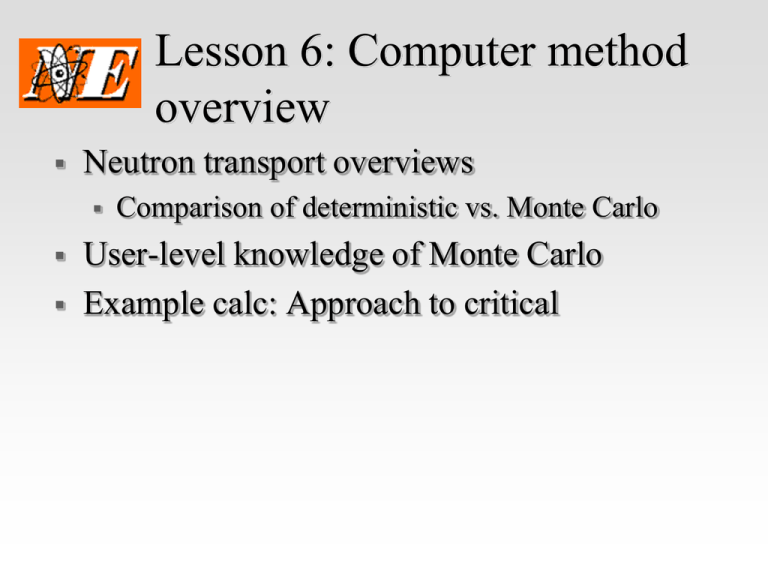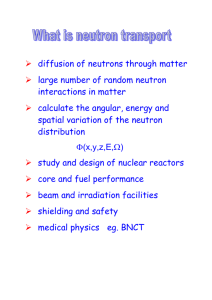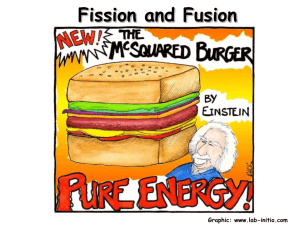Lesson6
advertisement

Lesson 6: Computer method overview Neutron transport overviews Comparison of deterministic vs. Monte Carlo User-level knowledge of Monte Carlo Example calc: Approach to critical Neutron transport overview Neutron balance equation Scalar flux/current balance J r , E a r , E r , E f r , E r , E S r , E Used in shielding, reactor theory, crit. safety, kinetics Problem: No source=No solution ! K-effective eigenvalue Changes , the number of neutrons per fission J r , E a r , E r , E f r , E r , E Advantages: Everybody uses it Guaranteed real solution Fairly intuitive (if you don’t take it too seriously) Good measure of distance from criticality for reactors Disadvantages: No physical basis Not a good measure of distance from criticality for CS Neutron transport Scalar vs. angular flux Boltzmann transport equation Deterministic Neutron accounting balance General terms of a balance in energy, angle, space Subdivide energy, angle, space and solve equation Get k-effective and flux Monte Carlo Numerical simulation of transport Get particular flux-related answers, not flux everywhere Deterministic grid solution Subdivide everything: Energy, Space, Angle “Eulerian” grid: Fixed in space Use balance condition to figure out each piece Source Spatial and angular flux for Group 1 (10 MeV-20 MeV) Stochastic solution Continuous in Energy, Space, Angle “Lagrangian” grid: Follows the particle Sample (poll) by following “typical” neutrons Absorbed Fissile Fission Particle track of two 10 MeV fission neutrons Advantages and disadvantages of each Advantages Discrete Ordinates (deterministic) Monte Carlo (stochastic) Disadvantages Fast (1D, 2D) Accurate for simple geometries Delivers answer everywhere: = Complete spatial, energy, angular map of the flux 1/N (or better) error convergence “Exact” geometry Continuous energy possible Estimate of accuracy given Slow (3D) Multigroup energy required Geometry must be approximated Large computer memory requirements User must determine accuracy by repeated calculations Slow (1,2,3D) Large computer time requirements 1/N1/2 error convergence Monte Carlo overview Monte Carlo We will cover the mathematical details in 3 steps 1. General overview of MC approach 2. Example walkthrough 3. Special considerations for criticality calculations Goal: Give you just enough details for you to be an intelligent user General Overview of MC Monte Carlo: Stochastic approach Statistical simulation of individual particle histories Keep score of quantities you care about Most of mathematically interesting features come from “variance reduction methods” Gives results PLUS standard deviation = statistical measure of how reliable the answer is Mathematical basis Statistical simulation driven by random number generator: 0<x<1, with a uniform distribution: p(xdxprob. of picking x in (x, x+dx)=dx Score keeping driven by statistical formula: N x xˆ x n 1 n N N 2 xˆ x n 1 xˆ 2 n N N 1 Simple Walkthrough Six types of decisions to be made: 1. 2. 3. 4. 5. 6. Where the particle is born Initial particle energy Initial particle direction Distance to next collision Type of collision Outcome of scattering collision (E, direction) How are these decisions made? Decision 1: Where particle is born 3 choices: 1. 2. Set of fixed points (first “generation” only) Uniformly distributed (first generation only) KENO picks point in geometry xmin x xmax , uniformly distributed x xmin x ( xmax xmin ) y ymin x ( ymax ymin ) z zmin x ( zmax zmin ) Rejected if not in fuel After first generation, previous generation’s sites used to start new fissions Decision 2: Initial particle energy From a fission neutron energy spectrum Complicated algorithms based on advanced mathematical treatments Rejection method based on “bounding box” idea Decision 3: Initial particle direction Easy one for us because all fission is isotropic Must choose the “longitude” and “latitude” that the particle would cross a unit sphere centered on original location Mathematical results: m=cosine of angle from polar axis 1 m 1, uniformly distribute d m 2x - 1 F=azimuthal angle (longitude) 0 2, uniformly distribute d 2x Decision 4: Distance to next collision Let s=distance traveled in medium with t Prob. of colliding in ds at distance s =(Prob. of surviving to s)x(Prob. of colliding in ds|survived to s) =(e- t s)x(ts) Using methods from NE582, this results in: s ln x t Decision 5: Type of collision Most straight-forward of all because straight from cross sections: s / t =probability of scatter a / t =probability of absorption Therefore, if x< s / t , it is a scatter Otherwise particle is absorbed (lost) “Weighting in lieu of absorption”=fancy term for following the non-absorbing fraction of the particle Decision 6: Outcome of scattering collision In simplest case (isotropic scattering), a combination of Decisions 3 and 5: “Decision 5-like” choice of new energy group sg g probabilit y of scatter from group g to group g' sg Decision 3 gets new direction In more complicated (normal) case, must deal with the energy/direction couplings from elastic and inelastic scattering physics Special considerations for criticality safety Must deal w/ “generations”=outer iteration Fix a fission source spatial shape Find new fission source shape and eigenvalue User must specify # of generations AND # of histories per generation AND # of generation to “skip” Skipped generations allow the original lousy spatial fission distribution to improve before we really start keeping “score” KENO defaults: 203 generations of 1000 histories per generation, skipping first 3 Approach to critical Approach to critical This is a brief overview of the basic techniques of running a critical experiment The very same techniques are used to bring a reactor from shutdown state to an initial zeropower critical condition The basic idea is to use the equations of subcritical multiplication to sneak up on the critical value of some parameter (i.e., one of the nine MAGICMERV parameters) Approach to critical (cont’d) We begin with the basic definition of keffective (which we will call “k” in our equations) The ratio of fission neutrons produced in any “generation” to those in the previous generation Actually, since the flux increases linearly with fission rate (if you are careful) any fluxdependent parameter can be used in place of the fission neutron production • We will use the response of an external detector In both practice and theory, there must be an external neutron source to give the system something to multiply Approach to critical (cont’d) If we assume an external source rate of S neutrons/generation, we can see that: 1. In the first generation, S neutrons will be released. Since no fission has taken place yet, these will be the only neutrons in the system. 2. In the second generation, S new neutrons will be released and the previous generation’s S neutrons will cause kS(<S) new neutrons to give us a population of: S (1 k ) Approach to critical (cont’d) 3. In the next generation, the same thing happens: S new neutrons will be released and the previous population is multiplied by k, giving us: S k S (1 k ) S (1 k k 2 ) 4. Following this through to an infinite series: S S (1 k k k ...) 1 k 2 3 Approach to critical (cont’d) 5. 6. The 1/(1-k) term is a MULTIPLIER of the source. It appears from first glance that this equation can be used to find k, but it really can’t, because we never really know what the original k is. But it CAN tell you is how much (relatively) closer your most recent change got you to k=1. For example, if you make a change and your detector reading goes from 100 counts/sec to 200 counts/sec, you DO know that you went HALFWAY to k=1. But you can’t tell whether you went from k=.8 to .9 or (maybe) 0.96 to 0.98 Approach to critical (cont’d) 7. This is useful because it tells you that ANOTHER change of (about) the same magnitude would get you to critical. Since criticality corresponds to the M=1/(1-k) term (the MULTIPLIER of the source) going infinite, we have found it is more useful to instead watch its inverse. Criticality corresponds to 1/M going to 0. (Inclass example as time allows)




